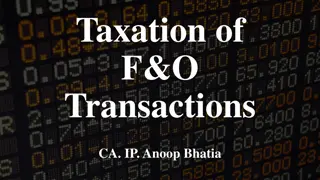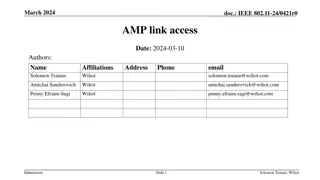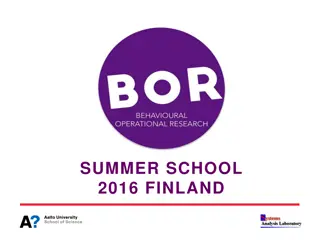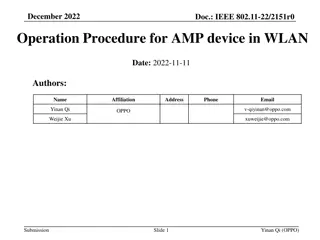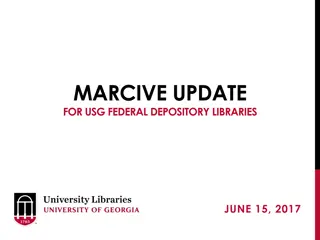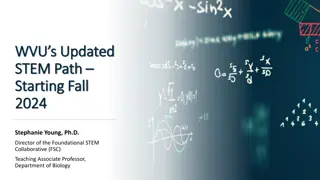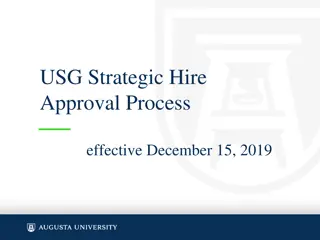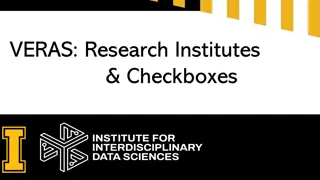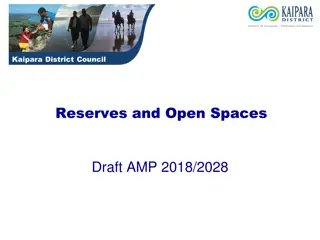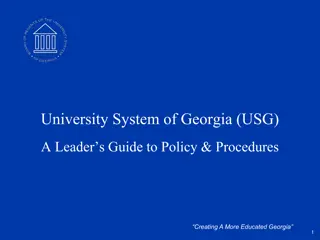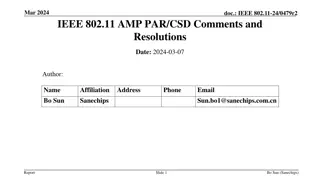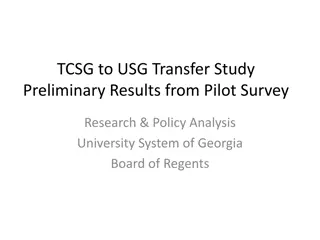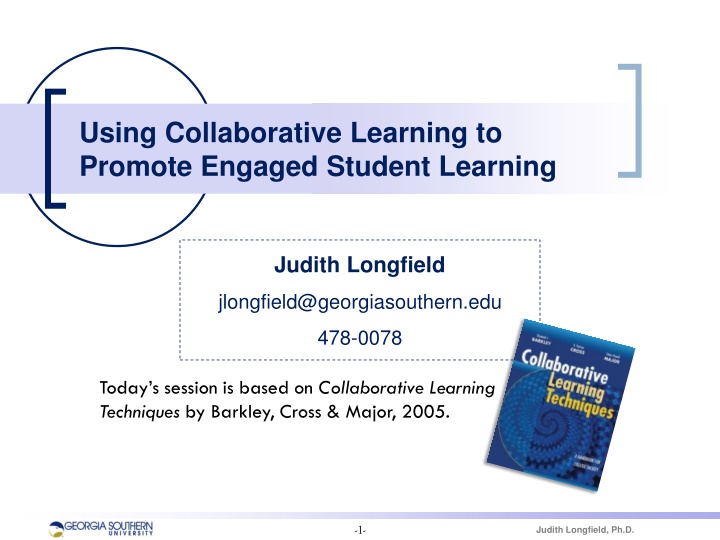
Utilizing Collaborative Learning for Enhanced Student Engagement
Explore the concepts of collaborative learning techniques to promote active student engagement. This session delves into intentional design, co-labor strategies, and meaningful learning outcomes within collaborative settings. Join in for a dynamic approach to fostering collaborative learning environments in education.
Download Presentation

Please find below an Image/Link to download the presentation.
The content on the website is provided AS IS for your information and personal use only. It may not be sold, licensed, or shared on other websites without obtaining consent from the author. If you encounter any issues during the download, it is possible that the publisher has removed the file from their server.
You are allowed to download the files provided on this website for personal or commercial use, subject to the condition that they are used lawfully. All files are the property of their respective owners.
The content on the website is provided AS IS for your information and personal use only. It may not be sold, licensed, or shared on other websites without obtaining consent from the author.
E N D
Presentation Transcript
Using Collaborative Learning to Promote Engaged Student Learning Judith Longfield jlongfield@georgiasouthern.edu 478-0078 Today s session is based on Collaborative Learning Techniques by Barkley, Cross & Major, 2005. -1- Judith Longfield, Ph.D.
Todays Agenda Speedy Introductions What Is Collaborative Learning? Task Force Simulation Flex: Your Choices . . . Orientating Students Forming Groups Learning Tasks Grading & Evaluation Wrap up -2- Judith Longfield, Ph.D.
Speedy Introductions In 20 seconds or less, introduce yourself to your partners: Your name Where you are from What you teach Do you currently use collaboration learning? ~ about 3minutes ~ -3- Judith Longfield, Ph.D.
What Is Collaborative Learning? Collaborative Learning Features: 1. Intentional design instructor doesn t just tell students to work in pairs or groups, structures a task to meet course objective(s) 2. Co-labor students actively work together to master the objective 3. Meaningful learning students must increase their knowledge or deepen understanding of course curriculum Barkley, E.F.; Cross, P.K.; & Major, C.H. (2005). Collaborative Learning Techniques . San Francisco: Jossey-Bass, pp. 4-5 -4- Judith Longfield, Ph.D.
Task Force Simulation CoLTask Force Scenario. VPAA asks you to serve on Collaborative Learning Task Force to study ways to increase retention, progression and graduation rates using Collaborative Learning Techniques (CoLTs). Which sub-committee would you & your colleagues like to serve on? Discussion CoLTs Reciprocal Peer Teaching CoLTs Problem Solving CoLTs Graphic Organizing CoLTs Writing CoLTs -5- Judith Longfield, Ph.D.
Task Force Simulation (cont.) What to Do: Using list your team selected, the TEAM LEADER assigns specific CoLTs to individuals. Each person reads his/her CoLT and then describes it to team. As a team, select the most useful CoLT to share it with session participants. Your team will describe it & tell how it could be used. ~ Reports begin in 15 minutes ~ Judith Longfield, Ph.D.
Task Force Meeting Meeting Agenda 1. Sub-Committee Reports Share best CoLT & explain how it could be used: Discussion CoLTs Reciprocal Peer Teaching CoLTs Problem Solving CoLTs Graphic Organizing CoLTs Writing CoLTs 2. Discussion Possible impact of CoLTs on retention, progression, & graduation rates 3. Implementation Strategies Judith Longfield, Ph.D.
What Would You Like to Know? Given the time remaining, what would you like to know? Orientating Students Forming Groups Learning Tasks Grading & Evaluation Wrap Up Note: Regardless of the option(s) selected, you will receive the handouts & PPTs if you provide me with your e-mail address. -8- Judith Longfield, Ph.D.
Orienting: Policies & Procedures Collaborative Learning Policies & Procedures in the Syllabus or Orientation Course syllabi typically include general course policies such as those regarding attendance, grading, and academic honesty. Classroom procedures (such as attendance monitoring) may be included in the syllabus, or may be covered in the first-day orientation. Consider incorporating one or more of the following elements either into the syllabus or orientation to help manage collaborative learning. Shared understanding of course policies & procedures is important to class cohesiveness Collaborative Learning Policy learning will be part of the course as well as plans for assessing and grading group work; this statement can help to make plans and expectations clear to students. Three Before Me Statement When choosing to implement an extensively collaborative class in which students will work as independently as possible, establish guidelines in advance. For example, Kagan (1992) asks student to consult three resources before asking him for a response. Classroom Set-up Team accordingly. Consider conserving time by assigning student to teams that are responsible for setting up the room as soon as they get to class (Cohen, 1886). A statement that summarizes why, how, and in what ways collaborative Syllabus Review - CoLTs 2, 3 & 12 Round Robin groups generate questions, read syllabus, find answers Buzz Groups read syllabus together & generate questions to ask of the class Create quiz & have groups work together to find answers related information or questions. If desired, the tickets can be used later to record attendance on a roster. It is also important to respond to student remarks to show students that their comments are important. Similar to the Entry Ticket, students can turn in Exit Tickets instead, submitting the slips of paper with their questions and comments at the end of class rather than at the beginning (Bender, Kendall, Larson, & Wilkes, 1994). Signal to Stop Group Work time to turn their attention to you. The signal should be something that s will easily recognize even if they are actively involved in group work, flashing the lights of ringing a desktop bell. When they see or hear this students should respond by stopping the conversation and making eye Students often expect instructors to jump in and provide them with the answers. With extensive use of small groups, the classroom needs to be set up Entry/Exit Ticket Taking attendance can be time consuming, and in courses in which student do considerable group work, it can delay or interrupt group interaction. Consider as an alternative having student complete and turn in tickets as they walk in the door for each class session. The Entry Tickets consist of a slip of paper on which student write their names as well as questions, comments, and topics that they would like to cover, problems regarding group work, or other course- Before starting group work, prearrange a signal that lets students know that is Barkley, E.F.; Cross, K.P.; & Major, C.H. (2005). Collaborative Learning Techniques. San Francisco, CA: Jossey-Bass. p. 33-35 with you (Millis & Cottell, 1998). By establishing the signal the first -9- Judith Longfield, Ph.D.
Orienting: Shared Understanding Shared understanding of course policies & procedures is important to class cohesiveness Syllabus Review - CoLTs 2, 3 & 12 Establish group work ground rules - CoLTs 2 & 20 Ask groups to make a list of helpful & unhelpful behaviors for groups use to develop rules Provide list & have students select most important ones Roles and responsibilities of each member F200 Teach-a-Chapter Group Contract A Group Contract is a document written by your team prior to starting work on your Teach-a-Chapter assignment. The purpose of the Contract is to get you, as future teachers, to develop your own rules of engagement and to formalize your objectives, roles, overall plan see Planning Guide, meeting schedule/timeline, preferred methods of communication and consequences of actions (or inactions) of group members. On the day of your Teach-a-Chapter presentation, each group member must submit the (1) Teach-a-Chapter Self- Evaluation and Group Collaboration form and (2) a written report (200-300 words) explaining what they did individually and how they contributed to the group project. Use the following template to create your Group Contract. The Group Contact must be agreed to, signed by all team members and handed in by Thursday, January 23. ~ ~ ~ ~ ~ ~ ~ ~ ~ ~ ~ ~ ~ ~ ~ ~ ~ ~ ~ ~ ~ ~ ~ ~ ~ ~ ~ ~ ~ ~ ~ ~ ~ ~ ~ ~ ~ Teach-a-Chapter ____ Group Contract Group member names & contact information Group learning contract Teach-a-Chapter Objectives Forming Groups Presentation components simulation, role play, PPT, Wiki, handouts, etc. Learning Tasks How are the parts of the presentation linked? Grading & Evaluation Wrap Up Target dates or timeline Barkley, E.F.; Cross, K.P.; & Major, C.H. (2005). Collaborative Learning Techniques. San Francisco, CA: Jossey-Bass. p. 36-37 -10- Judith Longfield, Ph.D.
Forming Groups: Types Types vary according to goal, activity, how long students remain together Informal Groups formed quickly, randomly, work together for brief periods - CoLTs 1 & 25 Formal Groups formed to achieve multifaceted goal (write report, give presentation), stay together until task completed (multiple sessions or weeks) - CoLTs 6 & 18 Base Groups stay together for longer periods, form learning community for support & encouragement - CoLTs 19, 24 & 30 -11- Judith Longfield, Ph.D.
Forming Groups Groups can be . . . Heterogeneous provides variety & diversity disadvantage = discomfort sharing ideas with others Homogeneous similar interests or characteristics disadvantages = lack of diversity Instructor-selected, heterogeneous groups often work better than student-selected or random groups. Barkley, E.F.; Cross, K.P.; & Major, C.H. (2005). Collaborative Learning Techniques. San Francisco, CA: Jossey-Bass. p. 45-50 -12- Judith Longfield, Ph.D.
Physical Settings Matter Forming Groups within Various Classroom Settings Some classrooms are more conducive to group work than others, but faculty can include collaborative activities in any kind of classroom. The following are suggestions for achieving collaborative work in specific types of classrooms (adapted for Silberman, 1996, pp. 10-16). Fixed Seat Auditorium or Lecture Hall Students seated next to each other on the same level can form pairs or trios. Although pairs can turn around in their seats for a limited period of time to work with the pair behind them, activities may best be limited to short brainstorming or brief discussions. Since groups are unable to work together for long periods in comfortable conditions, more complex collaborative assignments should be done outside of scheduled class time. Laboratories Laboratories most often contain workstations where groups of students can work together. Depending upon the kind of laboratory, groups of different sizes can form and re-form throughout the class section. For example, in a computer laboratory, pairs might best work for an assignment, but for brief periods another pair can gather and look over their shoulders, forming a quad. Moveable Desks Students can form pairs or small groups. Because students do not have a single shared workspace, writing together or manipulating pieces of paper (such as a concept map or web) may be challenging. Moveable Tables The flexibility offered by this type of setting makes it idea for a variety of group activities. In addition to pairs and pair-cluster arrangements; larger student teams work together at a table. The tables can be pulled together to create one large conference table. The tables and chairs may also be arranged in a U-shape. Almost any kind collaboration activity can be accomplished in this type of room. -13- Judith Longfield, Ph.D.
Changing Group Members Frequently or Not at All? Some groups will deteriorate have faith Keep groups intact for as long as possible Groups take time to mature Most valuable learning comes from working through problems Source: Barkley, E.F.; Cross, K.P.; & Major, C.H. (2005). Collaborative Learning Techniques. San Francisco, CA: Jossey-Bass. p. 50 Judith Longfield, Ph.D. ~ 14 ~
Changing Group Members Dealing with Hitchhikers and Free Loaders In general, you will find your F200 teammates as interested in learning as you are. Occasionally, however, you may meet someone who is unwilling or unable to cooperate, or who does not do her or his fair share of the work. It is important for you to learn to solve problems like this because you will deal with similar ones when you become a teacher. I ve come to realize that if I am not part of the solution, I am (often unknowingly) part of the problem. These how to tips, based on Suppose that you, Chadd, Alesha, and Denise are taking a course with Dr. Amenable, and are in an assigned work group. Denise, the Hitchhiker Denise, on the other hand, is nothing but a problem. Here are a few of the things she does: Denise rarely turns in her part of team assignments or projects. When she does, it s obvious she s spent just enough time to jot something down that give the impression of being related to the assignment, but you can t help wondering if she s even read the assignment requirements. When you try to set up team meetings, Denise can t meet because she s too busy. And when you do schedule one that is convenient for her (but inconvenient for everyone else on the team), she misses the meeting. She always promises she ll be there, but she never comes, or shows up five minutes before the meeting ends. Denise never answers phone messages. When you challenge her, she denies getting your messages. When you e- mail her, her mailbox is so full that your message is undeliverable. Denise s writing skills are okay, but she doesn t focus on the assignment at hand. She loses the drafts, doesn t reread her work, and fails to follow the assignment guidelines. You ve stopped assigning her work because you don t want to miss due dates. Denise constantly complains about her sixty-hour workweek, double clusters, unfeeling boyfriend, and terrible teachers. At first you felt sorry for her, but now you re just annoyed. The Problem: Absorbing In the above scenario, you were a member of an absorber group because you and your teammates absorbed the problem when Denise would not cooperate. You may have even taken pride in getting the job done whatever the Hitchhikers count on you to act in a benevolent, self-sacrificing way. As Dr. Oakley notes, the nicer you are (or think you are being), the more the hitchhiker will be able to hitchhike their way the university and through life Orientating Students Learning Tasks Grading & Evaluation Wrap Up Judith Longfield, Ph.D. ~ 15 ~
Collaborative Learning Tasks How to Structure the Learning Task 1. Design an appropriate task see CoLT samples 2. Structure procedures to actively engage students in task Create relevant task, vital to achieving course objective(s) Task matched to students skills & abilities Promote interdependency each student responsible to & dependent on others to succeed Ensure individual accountability Plan each phase of task in advance Barkley, E.F.; Cross, P.K.; & Major, C.H. (2005). Collaborative Learning Techniques . San Francisco: Jossey-Bass, pp. 55-59. -16- Judith Longfield, Ph.D.
Collaborative Learning Tasks Sample Task Prompts Question Type Exploratory Purpose Examples Probe facts and basic knowledge Examine assumptions, conclusions, and interpretations Ask for comparison of themes, ideas, or issues Probe motives or causes Call for a conclusion or action What research evidence supports _____? How else might we account for _____? What assumptions underlie this _____? How does _____ compare to _____? Challenge Relational Diagnostic Action Why did _____? In response to _____, what should _____? If _____ occurred, what would happen to _____? Cause and Effect Ask for causal relationships between ideas, actions, or events Expand the discussion Extension How does this _____ relate to what we have said previously? Suppose ___ had happened/bee case, would the outcome have b Orientating Students Forming Groups Hypothetical Pose a change in facts or issues Grading & Evaluation Wrap Up -17- Judith Longfield, Ph.D.
Grading & Evaluating Issues Grades are the coin of the realm. Things to consider: Individual accountability & positive group interdependence General grading guidelines What, how, & who of evaluating learning & assigning grades Not every activity needs to be graded but it is important to collect everything. Barkley, E.F.; Cross, K.P.; & Major, C.H. (2005). Collaborative Learning Techniques. San Francisco, CA: Jossey-Bass. p. 83-94 -18- Judith Longfield, Ph.D.
Accountability & Interdependence The Dilemma Individual grades provide individual accountability, but minimize group effort & can be difficult to determine Group grades ensure the group is held accountable but can prove opportunity for freeloaders & can be seen as unfair The Solution - CoLTs 12, 29 & 24 Structure the learning task so it requires both individual & group effort Ensure that individual & group effort are differentiated & reflected in the graded product. mgtstudiesstudent2 -19- Judith Longfield, Ph.D.
Peer Feedback: Groups Peer Presentation Feedback TEAM ______ Evaluated by playing card _________ Strongly Disagree Strongly Agree Undecided or Directions: Circle the appropriate number to indicate the degree to which you agree or disagree with the following statements. Disagree Neutral Agree From my point of view, . . . in-class presentation sequencing and pace was appropriate. 1 2 3 4 5 . . . I was actively engaged the whole time. 1 2 3 4 5 . . . every group member demonstrated enthusiasm/interest in the topic. 1 2 3 4 5 . . . activity promoted my understanding of concepts & was relevant. 1 2 3 4 5 . . . the Technology Project was eye-catching, inviting & easy to navigate. 1 2 3 4 5 . . . the use of technology encouraged me to think about critical issues. 1 2 3 4 5 . . . I feel well-prepared for a test on the concepts presented. 1 2 3 4 5 The most effective activity/part of the presentation was The most interesting/useful part of the Technology Project was -20- Judith Longfield, Ph.D.
Grading Groups _____________________________________ #_____ ___________________________________ #______ _____________________________________ #_____ ___________________________________ #______ _____________________________________ #_____ ___________________________________ #______ TEAM _____ Presentation & Technology Project Grade Sheet Strong = 5-4 pts. Satisfactory = 3-2 pts. Weak = 1-0 pts. 5 5 Technology Project ______ Points Strong Satisfactory Weak Eye catching, inviting, well-organized Contents encourage users to consider important teaching-learning issues Has useful internal & external links Very useful in preparing for Test 2 Excellent grammar/spelling, error free Colorful, interesting, organized Contents made users aware of teaching-learning issues Has internal & external links Helpful in preparing for Test 2 Good grammar/spelling, few error Not interesting, and/or organized Contents fact based, users not made aware of teaching-learning issues Links of limited use or few links Limited use in preparing for Test 2 Multiple grammar/spelling errors 4 4 In-Class Presentation ______ Points Well-timed, cohesive presentation Everyone showed enthusiasm Class actively engaged Lesson promoted deep understanding of chapter and teaching-learning issues All members participated actively Consistent presentation Most members showed interest Class generally engaged Lesson promoted basis under- standing of chapter contents Most members participated actively Disorganized presentation Showed little or no interest Class generally inattentive Mainly lecture with limited attempt to facilitate understanding 1-2 members dominated presentation -21- Judith Longfield, Ph.D.
Peer Feedback: Individuals Self-Evaluation and Group Collaboration What to Do. Use the form below to evaluate your self and the forms on the next page to evaluate your teammates. (1) Rate the items on the left-side using the +, , 0 scale. In the space on the right-side provide appropriate feedback honest and helpful. For example, Nice job on the Web activity; your design skills are extraordinary. Asking for assistance with proofreading will make it even more awesome. Feedback is required & should be word-processed to ensure anonymity. (2) Divide a TOTAL of 100 points among ALL Teach-a-Chapter group members including yourself. For example, if you couldn t make it to most of the meetings because you were sick, while another person took the lead and did most of the work; you might give yourself 10 points, the person who did most of the work 50 points, and the remaining two members 20 points each. However, if everyone, including yourself, did an equal amount of work, you would give yourself and your three teammates 25 points each. Record points in the shaded boxes. (3) Cut the evaluations apart & PAPER CLIP them together with your evaluation on top. Hand the paper clipped evaluations, along with your reflection [see assignment for details], directly to your instructor. Name ___________________________________ # _____ Self-Evaluation of _________________ Project Directions: Rate yourself on your participation using the scale below. + = exceeded expectations = met expectations 0 = did not meet expectations NA = not applicable Why did you distribute the points as you did? _____ Demonstrated positive attitude toward others & the task _____ Participated fully contributed productive suggestions. _____ Completed tasks on time & in a manner that contributed to overall success of project. _____ Worked through disagreements in a professional manner. _____ Was present at & arrived on time for ALL work sessions. Your Collaboration Points 0-100 -22- Judith Longfield, Ph.D.
Individual Grades Name _____________________________________ #_____ Individual Grade Sheet Strong = 5-4 pts. Satisfactory = 3-2 pts. Weak = 1-0 pts. ______ Points 3.5 3.5 Written Reflection 1 page Strong Satisfactory Weak Ideas generally clear, concise Generally talks about things learned Ideas unclear or poorly expressed Lacks in-depth reflection on learning Ideas communicated clearly, concisely Effectively reflects on areas of learning 5 5 Evaluation of Collaboration ______ Points Self-evaluation of contribution(s) astute & discerning Feedback professional & forthright Self-evaluation of contribution(s) generally thoughtful Feedback considerate, direct Self-evaluation of contribution unrealistic Feedback inappropriate 5 5 Overall Cooperation ______ Points Excellent cooperation with others Good cooperation with others Poor cooperation with others ____Technology Project 5 5 4 4 3.5 3.5 ______ Written Reflection 5 5 5 5 ______ In-Class Presentation ______ Evaluation of Collaboration Orientating Students ______ Overall Cooperation Forming Groups ________ Total Points 22.5 22.5 Learning Tasks Wrap Up -23- Judith Longfield, Ph.D.
Developing a Plan Lesson Planning Guide Course ________ Title/Topic _______________________________________ Date of Intended Use ___________ Student Learning Outcomes What is the big idea what I want students to be able to do or understand about (concept)_? Why is this important? What prerequisite skills/knowledge will students need in order to succeed? Do they have them? How can I find out? Misconceptions What common misconceptions are associated with (concept) ? How will I know if students have these misconceptions? What things can I do to confront & overcome students misconceptions? Materials What materials, handouts & supplies will I need? Do I have enough for everyone, plus extras?Do I know where all the items are, or how/where to get them? Cooperative/Collaborative Learning Components Should I group students heterogeneously or homogeneously? Do I need to teach interpersonal skills or do students already know how to work in groups? What should I do foster positive interdependence? How can I ensure individual accountability? How muc face-to-face interaction should there be? How will groups self-assess their functioning? -24- Judith Longfield, Ph.D.
Want to Know More? For more information on forming groups, introducing activities, observing & interacting with groups, addressing problems, grading/evaluating, and the types of CoLTs: Discussion Reciprocal Peer Teaching Problem-Solving Graphic Organizing Writing Collaborative Learning Techniques by Barkley, Cross & Major, 2005 -25- Judith Longfield, Ph.D.
Thanks! Gracias! Merci! Please return books & sign up to receive PPTs Judith Longfield jlongfield@georgiasouthern.edu 912.478.0078 -26- Judith Longfield, Ph.D.

